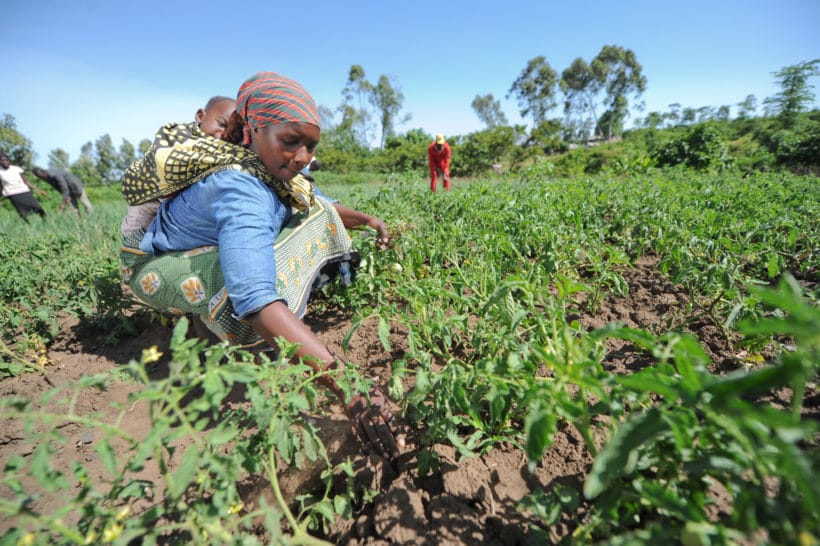
Photo: via Flickr
Sub-Saharan Africa is a fast-growing region of 1.2 billion people whose pathway to a more promising future requires navigating a complex array of food-related challenges, which have been greatly intensified by the COVID-19 pandemic. But over the long-term, pressures on food production caused by climate change loom as the biggest obstacle. And actions taken at the upcoming United Nations climate change conference in Glasgow, Scotland will be decisive in determining Africa’s capacity to adapt.
Specifically, world leaders must embrace a global climate finance plan that provides significant investments to help smallholder farmers and livestock keepers in Africa adapt to the stresses caused by climate change.
Africa’s food systems are anchored by small-scale food producers who also generate employment and income for the majority of Africans. Yet a growing number of challenges linked to climate change—like the drought and locust attacks currently threatening 2.1 million Kenyans with starvation—have hit Africa’s smallholder farmers and livestock keepers especially hard.
A recent study found that over the last 60 years, climate change has cut farm output globally by 21 percent. But in large areas of Africa, estimated losses exceed 40 percent. The Food and Agriculture Organization of the United Nations (FAO) has warned that COVID-19 has intensified this already deteriorating situation.
But even as they continue to grapple with the pandemic, African leaders are looking to a future where the continent’s fortunes will depend heavily on adapting to climate change. Earlier this year, they endorsed a pandemic recovery strategy focused on mobilizing $25 billion over the next five years to support an African Adaptation Acceleration Program, a goal backed by United Nations’ Secretary-General Antonio Guterres and U.S. Treasury Secretary Janet Yellen. It includes a strong focus on improving the resilience of small-scale crop and livestock producers.
But African countries cannot overcome climate challenges alone, nor should they. As Secretary Yellen noted, “Africa contributed the least to climate change, but it is suffering the worst effects.” Case in point: Africa accounts for only about four percent of the world’s greenhouse gas emissions.
Today, about three-quarters or more of climate financing goes toward reducing emissions. But we need to be just as ambitious and innovative with adaptation. Because even radical reductions right now won’t stop many of the changes already affecting African farmers and that are likely to intensify over the next few decades.
Secretary-General Guterres has called for G7 countries, along with institutions like the World Bank, to increase support for adaptation and resilience from 20 percent to 50 percent of their total climate finance.
Investments in adaptation should include a strong focus on agricultural innovations that target the needs of smallholder farming communities in Africa. Agriculture experts are already working in Africa to harness advances in data science and digital technologies. Such advances can be used to provide farmers with seasonal climate forecasts, technical advice and to track crop diseases likely to be made worse by climate change—like those threatening cassava in West Africa and wheat production in Ethiopia. There is evidence that such services can help farmers sustainably boost productivity by 30% and household income by 25%.
The CGIAR international system of agricultural research centers is a critical player for bringing these and other innovations to African farmers. In its decades of work, CGIAR has developed strong partnerships with farmers and national agricultural research centers across Africa. It’s practical advances—like the development of hundreds of improved varieties of beans for African farmers and its support of environmentally sustainable food production in Africa—is one reason every dollar invested in CGIAR has produced $10 in benefits for low-income countries.
CGIAR will be an especially valuable partner for implementing the African Union’s comprehensive African Adaption Initiative. That’s why the Global Commission on Adaptation called for doubling CGIAR’s budget as part of a broader blueprint for supporting adaptation in vulnerable communities around the world.
The Commission also emphasized that funding directly benefits communities in Africa and elsewhere that are on the frontlines of climate change. They should have a powerful voice in shaping adaptation initiatives. Local leaders—from pastoralist herders who have been living in the harsh drylands of the Horn of Africa for thousands of years to farmers in the African Sahel collaborating with researchers to create their own climate smart villages—have the experience and knowledge to develop effective strategies.
Climate change is putting African farmers under enormous pressure. Yet there are many ways to help them adapt and ensure they remain a strong partner for implementing the Food Systems Summit agenda in Africa. That’s why decisions made at the upcoming climate summit are of historical importance. A decisive move to rebalance global finance priorities will determine whether African farmers can adapt before it’s too late.
Rodger Voorhies is President of Global Growth & Opportunity at the Bill & Melinda Gates Foundation; and Wanjira Mathai is Vice President and Regional Director for Africa at World Resources Institute.

